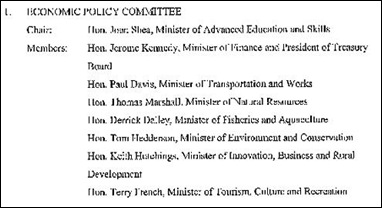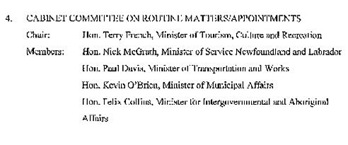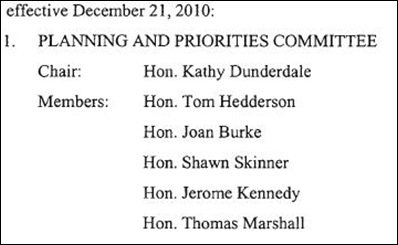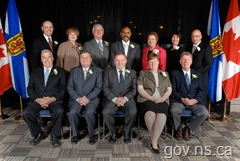One of the big changes Bill 29 made to the province’s access to information law was to give a list of documents that could not be released under the Access to Information and Protection of Privacy Act because they were cabinet documents.
Before then, the law in Newfoundland and Labrador, like the similar laws in the rest of the country merely said that people couldn’t get anything that would make public what the cabinet ministers talked about, in private, among themselves. A British Columbia government policy manual explains why:
Premature disclosure of Cabinet deliberations inhibits the ability of Cabinet members to debate issues openly and freely, thereby reducing the effectiveness of Cabinet’s decision making role.
One of the reasons no one bothered to define a cabinet document and bar that from disclosure is that no one could really say what a cabinet document is. People who’ve never dealt with cabinet or who have never had occasion to think about these things wouldn’t understand that how cabinet operates can vary widely from first minister to first minister. The changes made in Bill 29 reflect how cabinet operates these days but Paul Davis or any of the ministers who come along later may run cabinet in such a way that most of those mandatory exemptions of certain pieces of paper won’t matter a bit.
There’s no firm rule as to who may sit in the room with cabinet. Some administrations have allowed only the clerk of the council and a deputy clerk into the room to provide administrative support. Other people may come into the room and make a presentation but they get shuffled out of the room before cabinet discusses anything. In other administrations, they’ve had all sorts of hangers-on sitting in the room. Most often, the extra bodies are senior political people from the first minister’s office.
At times, the Executive Council hasn’t included everyone with a ministerial portfolio. And on occasion pretty well every cabinet will throw everyone out of the room and discuss something entirely among themselves. But there might never be a paper for them to read in advance, a note, a presentation or anything of the sort.

Even the form of the minute varies. These days, it includes a list of people who get a copy. There’s a number on it and the actual statement of the decision includes all sorts of references to the authority cited for making the decision.
Go back a hundred years and you will find piles of these minutes. They might be as little as a sentence or two. The certified minutes, the ones that needed the Governor’s signature, were written out long-hand in a book the Governor kept.
That’s where things get interesting. Note that the minute above refers to a meeting of the committee of the Executive Council. The ones a century ago that your humble e-scribbler has been reading lately say pretty much the same thing. That’s the another way of saying the Executive Council without the lieutenant governor present for the meeting. These days it is unheard of for the Queen’s representative to attend any meeting of the council, federal or provincial, here in Britain or anywhere else. A century ago, a committee of the council – cabinet ministers without the Governor - met to discuss all sorts of routine things, including budgets.
Back then, there were meetings of the Executive Council. They took place at Government House and, as near as your humble e-scribbler can figure, they included the Governor. A good example was the meeting held at 3:30 p.m. August 7, 1914 to decide on the Newfoundland contribution to the war. You can hunt for any record of the meeting in the cabinet papers and you’ll never find a mention. We know it happened, though, because the Governor refers to to it in letters. There’s a specific note in his type-written daily diary and the Prime Minister mentions it in a letter or two written around the same time. We know they discussed a proposal drafted by the Governor two days beforehand, apparently based on discussions with the Prime Minister. The version cabinet approved is not exactly what the Governor proposed.
There’s no record of that meeting, though, just as there is no record or any other meeting of the whole council during the period from about 1908 to 1914. There might be others but YHE-S hasn’t gotten to them yet.
There’s nothing odd about that, by the way. The British cabinet didn’t keep any record of decisions until after the war started. There could sometimes be a huge gulf among ministers about what, if anything, they’d discussed and decided. The only formal record of any sort through most of the 19th century was a letter written weekly by successive Prime Ministers to the Queen, for her information. Even then, what the Prime Minister said cabinet discussed and agreed on might not be what ministers recalled.
Incidentally, for those who might be wondering about the endless trips to Government House to appoint ministers lately, you need only check the Executive Council Act to see that it wasn’t necessary: “The Lieutenant-Governor in Council” – meaning the whole cabinet – “on the advice of the Premier may appoint a minister as acting minister for another minister during the absence or incapacity for any cause of that other minister, and all acts of an acting minister shall have the same effect as if done by the minister in whose place he or she is acting.”
They’ve appointed acting ministers countless times over the past decade, most often to cover off Charlene Johnson when she was on one kind of leave or another. Tom Marshall could have done exactly the same thing as ministers quit for one reason or another. The only question is why he chose to swear in new ministers and shuffle his cabinet around all the time.
-srbp-






